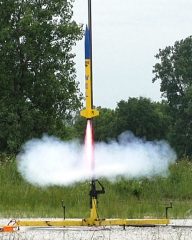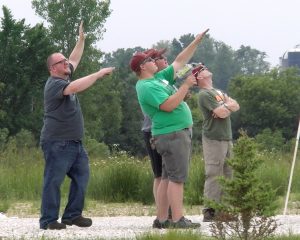 The space race usually conjures images of 1960s Cold War rivals: Astronauts vs. Cosmonauts and the often-feared USSR Sputnik satellite. It was a time in American history when NASA was establishing a space program—and a time that many have forgotten.
The space race usually conjures images of 1960s Cold War rivals: Astronauts vs. Cosmonauts and the often-feared USSR Sputnik satellite. It was a time in American history when NASA was establishing a space program—and a time that many have forgotten.
But for one University of Wisconsin Oshkosh student, the space race is something very real, is very now, and is much closer to home.
Drew Farwell, a physics major and nontraditional adult student, has entered into a space race for higher education—a race to see which university can be the first to launch a powered rocket into outer space.
Space, which is officially classified as the 62-mile mark above Earth’s surface, has been reached by only a handful of verified launches from amateur high powered rocket teams. Farwell is hoping his UW Oshkosh team can reach space, and beat the current world record for altitude in the summer of 2018.
A series of rocket launches are planned to get them to this goal. Two have already been completed, and the third launch is scheduled for Saturday, March 19 in Princeton, Ill.
“We hope to break the sound barrier and cross the two-mile marker for altitude,” Farwell said. “If we do that, UW Oshkosh will walk away with three awards from the National Association for Rocketry.”
A passion inspired by difficult events
 In 2012, Farwell nearly lost his life after contracting a deadly MERSA infection while recovering from one of four back surgeries. Upon recovery, the reflection of a near-death experience changed his life.
In 2012, Farwell nearly lost his life after contracting a deadly MERSA infection while recovering from one of four back surgeries. Upon recovery, the reflection of a near-death experience changed his life.
“It almost killed me,” Farwell said. “It’s one of those things where you realize that could have been it. I felt so small, and I had this need to discover where I fit in the scale of this universe.”
To satisfy his curiosity, he bought a telescope. That, Farwell said, was when his eyes were opened to the bigger picture.
“I wanted to see Jupiter. I wanted to see other galaxies. I started writing for an astronomy forum, and as I got to see and write more, I knew I wanted to go to school for physics,” he said.
Farwell enrolled at UW Oshkosh and became active in student activities for physics and astronomy. After finding that his curiosity fit in with the students and faculty in the physics department, he poured his determination into the High Powered Rocketry Project.
UW Oshkosh astronomer Nadia Kaltcheva is serving as Farwell’s mentor. She said that she was most impressed by Farwell’s determination and drive.
“When Drew approached the physics department with the High Powered Rocketry Project, we were impressed by his knowledge and passion,” Kaltcheva said. “This is an excellent promotion of science and technology to students at every level.”
Not your average model rocket
Farwell and his team are using technically classified high-powered rockets. Quite different, he said, from the traditional model rocket that people order online or buy from a store.
A standard model rocket is about a foot long and puts out 50 pounds of thrust. The rockets Farwell uses are several feet tall and put out a minimum of 1,050 pounds of thrust per second with at least a three-second burn.
Farwell said, “It’s like the difference between a BB gun and an anti-tank weapon.”
Fashioned with aircraft-grade epoxy and carbon fiber, Farwell constructs the rockets in his basement.
“I am married to the most understanding woman who has ever existed,” he said.
Kaltcheva observed Farwell throughout the build process for the two completed launches and the one planned for March 19.
“Often we don’t realize the amount of knowledge and effort needed to get to the point to launch a rocket,” she said. “It took four months for Drew to build this one.”
In addition to the physical build, the planning for the launch, Kaltcheva said, took a considerable amount of work.
“Just to determine compliance with the launch regulations of the National Association of Rocketry, more than 100 flight simulations were run to figure out the strewn field for a flight with a 12-second motor burn,” she said.
The race to space with a larger goal in mind
While Farwell hopes to represent the first university to reach space, he has a higher achievement in his sights. He wants to beat the world record for amateur rocket altitude.
“A gentleman named Ky Michaelson holds the altitude record of 73.1 miles,” Farwell said. “We want to far surpass that.”
Michaelson is well-known in the high powered rocketry circuit. He goes by the nickname “Rocketman,” and he holds more than 100 world records in various science, rocket and technology fields.
Even though there is a natural rivalry with Michaelson, Farwell said he couldn’t have found a more supportive competitor.
“We had the pleasure of meeting Ky,” Farwell said. “I get the feeling that he’s hungry for competition, and he was more than willing to talk with us about rocketry.”
Michaelson even donated the deployment bags and parachutes for UW Oshkosh’s final two rocket launches, which includes the launch that will attempt to break his own record.
This equipment donation is one example of financial support that Farwell needs in order to accomplish his goals. As a student-led initiative in the midst of a budget crunch, the UW Oshkosh High Powered Rocketry Project receives no funding from the University.
“Up until now, I have been able to cover the costs of the rockets and the certifications,” he said. “But we’re currently raising money for the record-breaking launch, and we need $250,000.”
So far, Farwell and his group have raised $1,500 from individual and corporate sponsors. They are raising money using the non-profit crowdsourcing website, gofundme.com.
“The current record-holding rocket cost $500,000 to launch. We’re hoping to beat it by spending half of that.”
The difference between a goal and a vision
For Farwell, his goal of beating the world record is only part of his long-term plans at UW Oshkosh.
“I’m building rockets right now,” he said. “But what I really want to do is build a space program.”
His incremental approach to achieving the ultimate altitude goal begins his legacy at UW Oshkosh.
“Drew is a very driven person, always looking for new challenges,” Kaltcheva said. “Because of his dedication to the High Powered Rocketry Project we believe that this will become a significant program at UW Oshkosh.”
Farwell knows that UW Oshkosh might not be the first university to enter space, but that hasn’t altered his determination.
“We’re a bit of an underdog,” Farwell said. “We’re not MIT—we don’t have a six-figure budget.”
Going after his goal with a very limited budget, however, is something Farwell says gives him an advantage.
“They don’t have to be as creative in their methods, like I do,” he said. “Those other schools are focused on getting to space, but I have a higher goal of the world record. Even if we’re not the first, I hope we’ll be the best.”
In the short term, success on March 19 will mean Farwell launches a supersonic, high-powered rocket that clears the two-mile marker in altitude. He also is testing some equipment and technology that he will carry forward to the remaining three launches.
This includes using carbon dioxide rather than black powder for ignition, as well as an electronic deployment system rather than a fuse. All of this is not necessary for the altitude he hopes to reach on Saturday, but will be necessary for the final launch.
“In the industry they would call this ‘overbuilt.’ But I call it ‘purpose built,” he said. “Everything we do from here forward will be focused on testing for our final launch.”
Saturday’s launch is critical to Farwell’s eventual goal, though he still has humor about what could take place.
“It will take three seconds to go up,” he said. “If things go well, it should take about three and a half minutes to come down. If things don’t go well, it’ll be about 45 seconds. We’re obviously hoping for the best, but no matter what happens we know it’s going to be amazing.”
To learn more about the UW Oshkosh High Powered rocketry project, or to donate, visit uwosh.space and gofundme.com/uwohpr.
